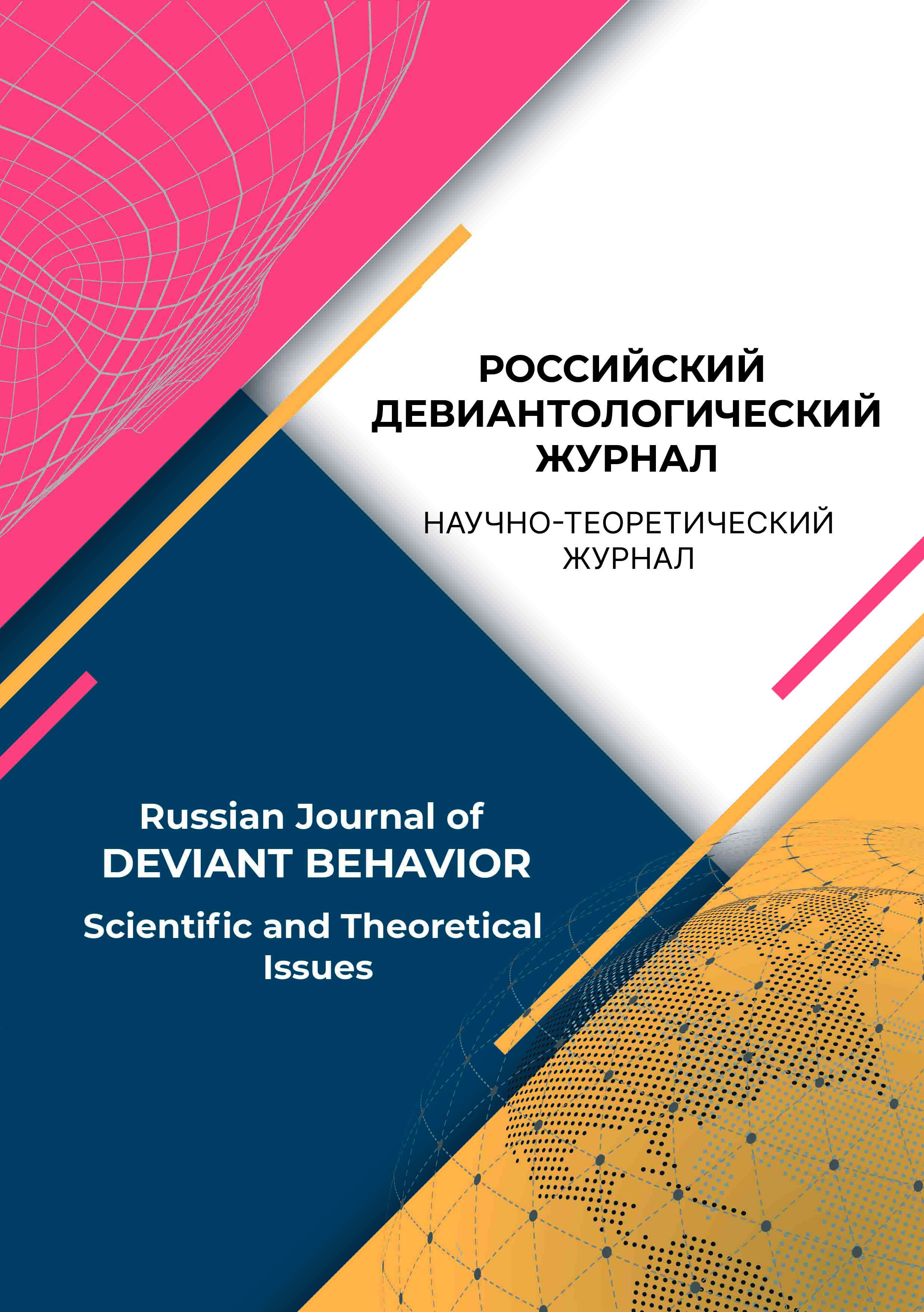Moscow, Moscow, Russian Federation
Russian Federation
Introduction. The importance of this research subject reflects the fact that deviant behavior has a strong risk factor for social deprivation. The expansion of prevention methods with new means can improve the qualitative efficiency of practical work. A key part of psychological work is also the creation of methods for identifying and responding to bullying facts in the process of observation and training. Developing empathy, identifying and preventing bullying can be considered as a new form of visualization. Objective. Analysis of the modeling basis of the gamification method for correctional training. Methodology. Theoretical work in which the relationship between gamified learning methods and psychological phenomena that can have a productive effect on socialization is analyzed. The experience of introducing gamification in other studies for psychological support is analyzed. Using the data obtained by Russian and foreign psychologists, the authors have examined the possibility of applying the principles of gamification as a tool of correcting bullying and aggressive behavior. Results. As a result, modern examples of the use of gamified programs in the field of empathy development and prevention of aggressive behavior were selected and described. Taking into account the foreign experience and local examples, the authors make a conclusion about the effectiveness of the use of these methods.
gamification, bullying, empathy, correction of aggression
1. Bityanova, M. R. (red.) (2008). Praktikum po psihologicheskim igram s det’mi i podrostkami. Saint Petersburg: Piter.
2. Zhdakaeva, E. I. (2011). Igrovaya terapiya kak sredstvo korrekcii destruktivnyh detsko-roditel’skih otnoshenij. Omskij nauchnyj vestnik, 6 (102), 160-163.
3. Ivanova, E. N. (2019). Psihologicheskaya igra - kak effektivnaya psihotekhnologiya v metodicheskoj i konsul’tativnoj rabote. Prikladnaya psihologiya na sluzhbe razvivayushchejsya lichnosti: Sbornik nauchnyh statej i materialov XVI nauchno-prakticheskoj konferencii s mezhdunarodnym uchastiem (str. 75-79). Kolomna: Gosudarstvennyj social’no-gumanitarnyj universitet.
4. Novikova, M. A., Rean, A. A. (2019). Vliyanie shkol’nogo klimata na vozniknovenie travli: otechestvennyj i zarubezhnyj opyt issledovaniya. Voprosy obrazovaniya, 2, 78-97. https://doi.org/10.17323/1814-9545-2019-2-78-97
5. Novikova, M. A., Rean, A. A., Konovalov, I. A. (2021). Bulling v rossijskih shkolah: opyt diagnostiki rasprostranennosti, polovozrastnyh osobennostej i svyazi so shkol’nym klimatom. Voprosy obrazovaniya, 3, 62-90. https://doi. org/10.17323/1814-9545-2021-3-62-90
6. Rean, A. A. (2015). Faktory riska deviantnogo povedeniya: semejnyj kontekst. Nacional’nyj psihologicheskij zhurnal, 4(20), 105-110. https://doi.org/10.11621/npj.2015.0410
7. Rean, A. A. (red.) (2017). Psihologiya deviantnosti. Deti. Obshchestvo. Zakon: monografiya. Moskow: YuNITI-DANA.
8. Rean, A. A. (2018). Profilaktika agressii i asocial’nosti nesovershennoletnih. Nacional’nyj psihologicheskij zhurnal, 2(30), 3-12. https://doi.org/10.11621/npj.2018.0201
9. Sarafanova, L. V. (2012). Process viktimizacii podrostkov i pedagogicheskie vozmozhnosti ego preduprezhdeniya. Vestnik Tambovskogo universiteta. Seriya: Gumanitarnye nauki, 3(107), 157-161.
10. El’konin, D. B. (1999). Psihologiya igry. 2-e izd. Moskow: Gumanitarnyj izdatel’skij centr VLADOS».
11. Anderson, C. A., & Dill, K. E. (2000) Video Games and Aggressive Thoughts, Feelings, and Behavior in the Laboratory and in Life. Journal of Personality and Social Psychology, 78(4), 772-790. http://dx.doi.org/10.1037/0022-3514.78.4.772
12. Bachen, C. M., Hernández-Ramos, P. F., & Raphael, C. (2012). Simulating REAL LIVES: Promoting Global Empathy and Interest in Learning Through Simulation Games. Simulation&Gaming, 43 (4). 437-460. https://doi.org/10.1177/1046878111432108
13. Bagès, C., Hoareau, N., & Guerrien, A. (2020). Play to Reduce Bullying! Role-Playing Games Are a Useful Tool for Therapists and Teachers. Journal of Research in Childhood Education, 35(4), 631-641. https://doi.org/10.1080/025685 43.2020.1810834
14. Calvo-Morata, A., Rotaru, D. C., Alonso-Fernandez, C., Freire, M., Martinez-Ortiz, I., Fernández-Manjón, B. (2018). Val¬idation of a Cyberbullying Serious Game Using Game Analytics. IEEE Transactions on Learning Technologies, 13(1), 186-197. https://doi.org/10.1109/TLT.2018.2879354
15. DeRosier, M. E., & Thomas, J. M. (2019). Hall of Heroes: A Digital Game for Social Skills Training with Young Adolescents. International Journal of Computer Games Technology, Article ID 6981698. https://doi.org/10.1155/2019/6981698
16. DeSmet, S., Bastiaensens, K., Van Cleemput, Poels, K., Vandebosch, H., Deboutte, G., Herrewijn, L., Malliet, S., Pabian, S., Van Broeckhoven, F., De Troyer, O., Deglorie, G., Van Hoecke, S., Samyn, K., & De Bourdeaudhuij, I. (2018). The efficacy of the Friendly Attac serious digital game to promote prosocial bystander behavior in cyberbullying among young adolescents: A cluster-randomized controlled trial. Computers in Human Behavior, 78, 336-347. https://doi.org/10.1016/j.chb.2017.10.011
17. Dirksen, J., & Ditommaso, D., & Plunkett, C. (2019). Augmented and Virtual Reality for Behavior Change. The Learning Guild. https://doi.org/10.13140/RG.2.2.23504.35842
18. Dyer, E., Swartzlander, B. J., & Gugliucci, M. R. (2018). Using virtual reality in medical education to teach empathy. Journal of the Medical Library Association: JMLA, 106(4), 498-500. https://doi.org/10.5195/jmla.2018.518
19. Dinh, H. Q., Walker, N., Hodges, L. F., Chang Song, & Kobayashi, A. (1999). Evaluating the importance of multi-sensory input on memory and the sense of presence in virtual environments. Proceedings IEEE Virtual Reality, 99CB36316, 222-228. https://doi.org/10.1109/VR.1999.756955
20. Kors, M. J. L., Ferri, G., van der Spek, E. D., Ketel, C., & Schouten, B. A. M. (2016). A Breathtaking Journey. On the Design of an Empathy-Arousing Mixed-Reality Game. CHI PLLAY ’16: Proceeding of the 2016 Annual Symposium on Computer-Human Interaction in Play, 91-104. https://doi.org/10.1145/2967934.2968110
21. Lobbestael, J., & Cima, M. J. (2021) Virtual Reality for Aggression Assessment: The Development and Preliminary Results of Two Virtual Reality Tasks to Assess Reactive and Proactive Aggression in Males. Brain Sciences, 11(12), 1653. https://doi.org/10.3390/brainsci11121653
22. Lyons, S. (2022). Cooperative Games in Education: Building Community Without Competition, Pre-K-12, Chapter 8. Teachers College Press.
23. Milgram, P., & Kishino, F. (1994). A Taxonomy of Mixed Reality Visual Displays. IEICE Transactions on Information and Systems, 12(12), 1321-1329.
24. Sapouna, M., Wolke, D., Vannini, N., Watson, S., Woods, S., Schneider, W., Enz, S., Hall, L., Paiva, A., Andre, E., Dautenhahn, K., & Aylett, R. (2010). Virtual learning intervention to reduce bullying victimization in primary school: A controlled trial. Journal of Child Psychology and Psychiatry and Allied Disciplines, 51(1). 104-112. https://doi. org/10.1111/j.1469-7610.2009.02137.x
25. Sitzmann, T. (2011). A meta-analytic examination of the instructional effectiveness of computerbased simulation games. Personnel Psychology, 64(2), 489-528.
26. Way, N., Reddy, R., & Rhodes, J. (2007). Students’ Perceptions of School Climate during the Middle School Years: Associations with Trajectories of Psychological and Behavioral Adjustment. American Journal of Community Psychology, 3-4(40), 194-213. https://doi.org/10.1007/s10464-007-9143-y
27. Werbach, K. (2022). Gamification. Cursera, The University of Pennsylvania. URL: https://www.coursera.org/learn/gamification
28. Zych, I., Farrington, D. P., Llorent, V. J., & Ttofi, M. M. (2017) Protecting Children against Bullying and its Consequences. Springer. https://doi.org/10.1007/978-3-319-53028-4

















